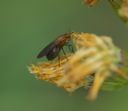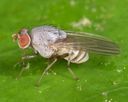Lauxaniidae
Lauxaniidae
Classification
- Phylum: Arthropoda
- Subphylum: Hexapoda
- Class: Insecta
- Order: Diptera
- Superfamily: Lauxanioidea
- Family: Lauxaniidae
Pronunciation
How to pronounce Lauxaniidae: //lɔːkˈsænɪaɪdiː//
These audio files are automatically generated. While they are not always 100% accurate, they are a good starting point.
Images






Summary
Lauxaniidae is a family of small, acalyptrate flies characterized by their small size and often brightly colored large compound eyes. They primarily inhabit wooded areas and play a role in the decomposition of organic material.
Physical Characteristics
Small flies (2–7 mm in length) with body color varying from yellow to brown or black. They generally have large compound eyes that may be brightly colored, sometimes with horizontal stripes. Their wings can be marked or unmarked, and wing venation is complete; the costa is continuous, and the subcosta is entire, ending in the costa.
Identification Tips
Distinguished from other muscoids by the complete subcosta, absence of oral vibrissae, and converging postverticals. Lauxaniids have two strong bristles above each eye, while Drosophilids typically have one strong bristle facing backward and others facing forward.
Habitat
Woodlands, forests, often found in moist shady places.
Distribution
Cosmopolitan distribution; most species are found in tropical regions of Asia and the Americas. Fewer than 200 species have been described in Europe.
Diet
Larvae are primarily saprophagous, feeding on decaying vegetation, leaf litter, or in bird nests.
Ecosystem Role
Larvae contribute to the decomposition process by breaking down decaying organic matter.
Similar Taxa
Tags
- Lauxaniidae
- Diptera
- insects
- small flies
- woodlands